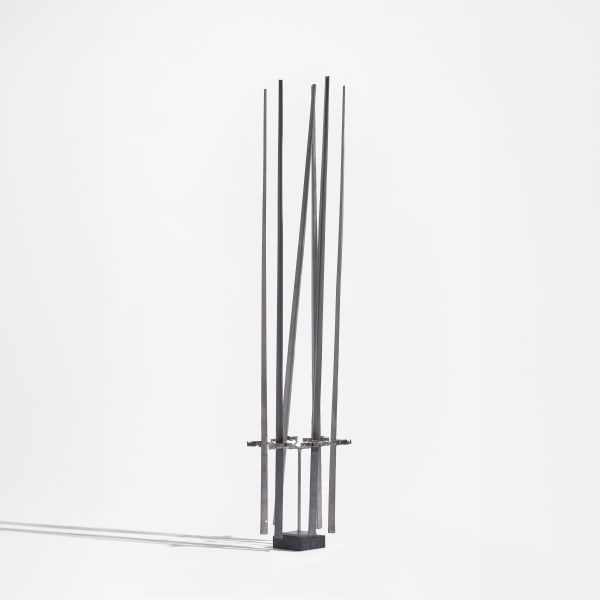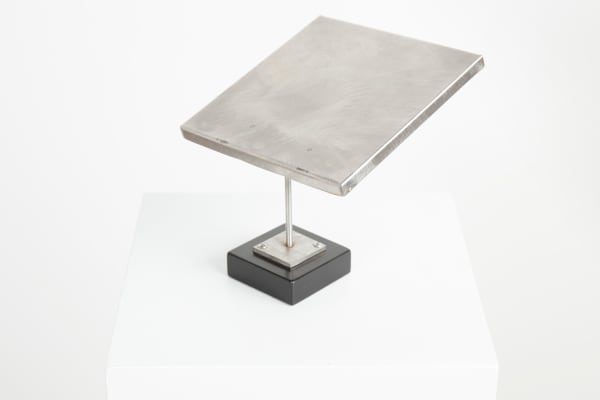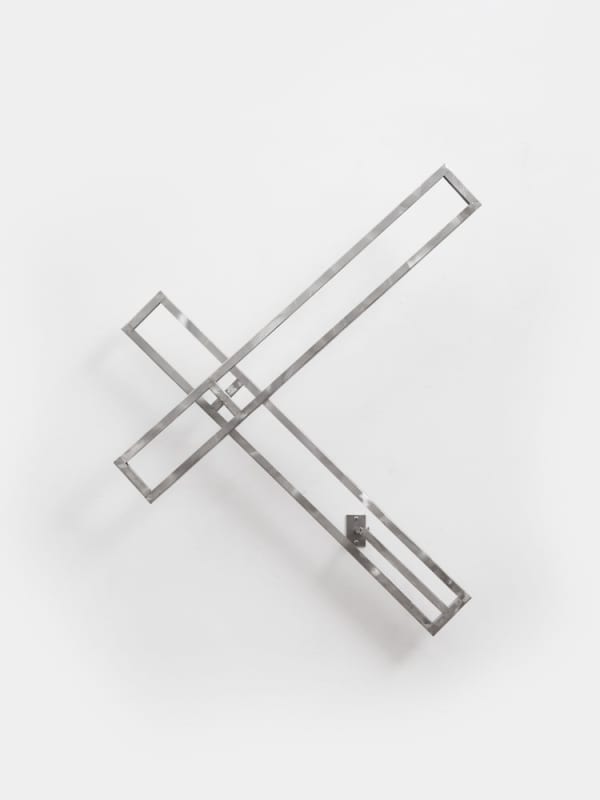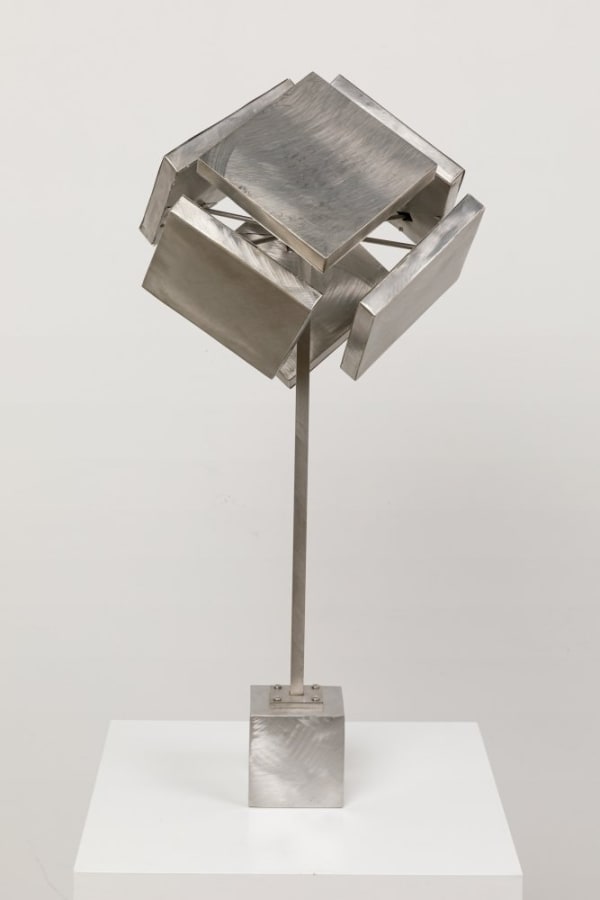"I try to make sculpture that will not just stand there but will move with the wind, so the eye will see it in different positions all the time."
-
 George RickeyCluster of Cubes (Three) on Gimbal, c.1992stainless steel
George RickeyCluster of Cubes (Three) on Gimbal, c.1992stainless steel
unique81.3 x 58.4 x 63.5 cm
32 x 23 x 25 in -
 George RickeyColumn of Five Lines with Gimbal II, 1990stainless steel274.3 x 45.7 x 45.7 cm
George RickeyColumn of Five Lines with Gimbal II, 1990stainless steel274.3 x 45.7 x 45.7 cm
108 x 18 x 18 in -
 George RickeyColumn of Six lines with Gimbals, 1975stainless steel94.6 x 17.8 x 17.8 cm
George RickeyColumn of Six lines with Gimbals, 1975stainless steel94.6 x 17.8 x 17.8 cm
37 1/4 x 7 x 7 in -
 George RickeyConstruction, 1951-52steel, polychrome
George RickeyConstruction, 1951-52steel, polychrome
unique63.5 x 68.6 x 43.18 cm
25 x 27 x 17 in -
 George RickeyConversation – Mondrian Meets Malevich, 1990stainless steel30 x 9 1/2 x 8 in
George RickeyConversation – Mondrian Meets Malevich, 1990stainless steel30 x 9 1/2 x 8 in
76.2 x 24.1 x 20.3 cm -
 George RickeyFixed and Moving Tetrahedra II, 1971stainless steel
George RickeyFixed and Moving Tetrahedra II, 1971stainless steel
unique81.3 x 73.7 x 73.7 cm
32 x 29 x 29 in -
 George RickeyOne Slender Line Horizontal, 1994stainless steelBlade: 94 cm | 34 1/4 in
George RickeyOne Slender Line Horizontal, 1994stainless steelBlade: 94 cm | 34 1/4 in
Height: 87 cm | 37 in -
 George RickeyOne Up One Down Oblique, Var.III, 1975stainless steel60 x 42 cm
George RickeyOne Up One Down Oblique, Var.III, 1975stainless steel60 x 42 cm
21 1/4 x 18 1/8 in -
 George RickeyOpen Rectangles One Up One Down Excentric with Acute Angle II, 1978stainless steel - outdoor151 x 22 in
George RickeyOpen Rectangles One Up One Down Excentric with Acute Angle II, 1978stainless steel - outdoor151 x 22 in
383.5 x 55.9 cm -
 George RickeySingle Line, 1964-1970stainless steel
George RickeySingle Line, 1964-1970stainless steel
unique29.2 x 49.5 x 7.6 cm
11 1/2 x 19 1/2 x 3 in -
 George RickeySingle Line or One Line Horizontal (Documenta III edition), 1964Stainless steel and wood - Unique work (Prototype for edition of 100)25.4 x 45.7 cm
George RickeySingle Line or One Line Horizontal (Documenta III edition), 1964Stainless steel and wood - Unique work (Prototype for edition of 100)25.4 x 45.7 cm
10 x 18 in -
 George RickeySix Triangles Hexagon Wall, 1978stainless steel46 x 50 x 13 in
George RickeySix Triangles Hexagon Wall, 1978stainless steel46 x 50 x 13 in
116.8 x 127 x 33 cm -
 George RickeySquare I, 1967stainless steel15.2 x 12.7 x 15.2 cm
George RickeySquare I, 1967stainless steel15.2 x 12.7 x 15.2 cm
6 x 5 x 6 in -
 George RickeyTriple N Tapered Gyratory, 1987stainless steel66 x 94 cm
George RickeyTriple N Tapered Gyratory, 1987stainless steel66 x 94 cm
26 x 37 in -
 George RickeyTwo Lines Leaning VII, 1972-73stainless steel and teak base53 in
George RickeyTwo Lines Leaning VII, 1972-73stainless steel and teak base53 in
134.6 cm
unique -
 George RickeyTwo Lines Oblique Five Feet, 1967Stainless Steel
George RickeyTwo Lines Oblique Five Feet, 1967Stainless Steel
unique254 x 180 cm
100 x 70 13/16 in -
 George RickeyTwo Lines Temporal, 1963-69stainless steel54.6 x 7.6 x 7.6 cm
George RickeyTwo Lines Temporal, 1963-69stainless steel54.6 x 7.6 x 7.6 cm
21 1/2 x 3 x 3 in -
 George RickeyTwo Open Rectangles Diagonal Jointed - Wall, 1985 (begun 1984)stainless steel101.6 x 101.6 cm
George RickeyTwo Open Rectangles Diagonal Jointed - Wall, 1985 (begun 1984)stainless steel101.6 x 101.6 cm
40 x 40 in -
 George RickeyTwo Open Triangles Up (Non-gyratory) , 1982stainless steel - outdoor116 x 57 x 9 in
George RickeyTwo Open Triangles Up (Non-gyratory) , 1982stainless steel - outdoor116 x 57 x 9 in
294.6 x 144.8 x 22.9 cm -
 George RickeyTwo Up Two Down (Maquette for San Fernando Valley State College), 1967stainless steel
George RickeyTwo Up Two Down (Maquette for San Fernando Valley State College), 1967stainless steel
unique101.6 x 10.2 cm
40 x 4 in -
 George RickeyUnstable Cube III, 1969-70stainless steel
George RickeyUnstable Cube III, 1969-70stainless steel
unique25 x 14 x 14 in
63.5 x 35.6 x 35.6 cm
-
 George RickeyUnstable Rhombus ll , 1983stainless steel53 x 95 x 12 cm
George RickeyUnstable Rhombus ll , 1983stainless steel53 x 95 x 12 cm
20 7/8 x 37 3/8 x 4 3/4 in
Blades: 48.3 cm x 50.8 cm | 19 x 20 in -
 George RickeyUnstable Square III, 1971stainless steel26 x 20 in
George RickeyUnstable Square III, 1971stainless steel26 x 20 in
66 x 50.8 cm -
 George RickeyUnstable Squares Diagonal Wall, 1981stainless steel59 x 56 x 8 in
George RickeyUnstable Squares Diagonal Wall, 1981stainless steel59 x 56 x 8 in
149.9 x 142.2 x 20.3 cm -
 George RickeyOne Line Up with Gimbal, 1986-87stainless steel
George RickeyOne Line Up with Gimbal, 1986-87stainless steel
unique223.5 x 25.4 x 25.4 cm
88 x 10 x 10 in -
 George RickeyFive Lines in Parallel Planes, 1966stainless steel
George RickeyFive Lines in Parallel Planes, 1966stainless steel
Unique772.2 x 685.8 cm
304 x 270 in
-
 30 Years 2 - 31.8.2025 Gallery | Knokke KustlaanPUBLIC OPENING August 9, 2025, 11 am – 7 pm Kustlaan 90, Knokke 8300 Thirty years ago, MARUANI MERCIER opened its doors at rue de la Régence with a a...Read more
30 Years 2 - 31.8.2025 Gallery | Knokke KustlaanPUBLIC OPENING August 9, 2025, 11 am – 7 pm Kustlaan 90, Knokke 8300 Thirty years ago, MARUANI MERCIER opened its doors at rue de la Régence with a a...Read more -

Drawing in Space
George Rickey 13.3 - 12.4.2025 Gallery | BrusselsPUBLIC OPENING March 13, 2025, 4 – 7 pm Avenue Louise 430, Brussels 1050 MARUANI MERCIER is pleased to present George Rickey: Drawing in Space , an exhibition of important...Read more
-

Art Basel Miami Beach 2025
3 - 7.12.2025We are delighted to announce our participation in Art Basel Miami Beach 2025, where we will present a thoughtfully curated selection of paintings, sculptures, and...Read more -

Frieze Masters 2025
15 - 19.10.2025MARUANI MERCIER is delighted to present a distinguished collection of artworks at Frieze Masters 2025, featuring important pieces by Salvador Dalí , Jean Dubuffet ,...Read more -
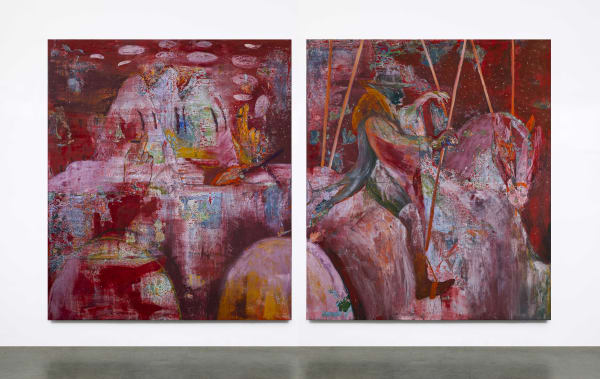
Art Brussels 2025
24 - 27.4.2025We look forward to returning to the 41st edition of Art Brussels with a group exhibition highlighting an eclectic range of works by artists including...Read more -
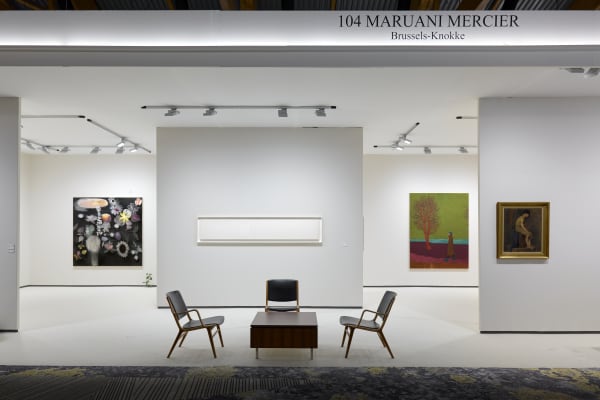
BRAFA 2025
26.1 - 2.2.2025We are pleased to return to BRAFA, celebrating its 70th edition, where we will present a group of historic works in tandem with contemporary highlights...Read more



